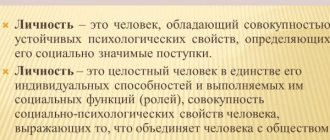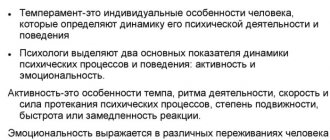The essence of cognitive processes and their types
Definition 1
Cognitive processes are a complex of mental functions that ensure the subject’s reflection and cognition of the phenomena of the objective world.
Note 1
The cognitive sphere of personality includes sensations, perceptions, imagination, attention, memory, thinking, and speech.
In cognition of the surrounding world, the primary psychological process is sensations, which are a reflection of the individual properties of objects that affect the human senses. The main part of each sense organ is the receptors, i.e. endings of the sensory nerve. Sensations are objective and subjective, if in the first case they always reflect an external stimulus, then in the second case they depend on the state of the nervous system and the individual characteristics of the person.
Are you an expert in this subject area? We invite you to become the author of the Directory Working Conditions
I. Sherrington identifies three main classes of sensations:
- exteroceptive, occurring when receptors are exposed to external stimuli,
- interoreceptive, forming organic feelings, for example, hunger,
- proprioceptive, with the help of which the brain receives information about the movement and position of body parts.
The minimum magnitude of the stimulus has a barely noticeable sensation and refers to its lower threshold. A person does not perceive signals whose intensity is less than the lower threshold. The maximum magnitude of the stimulus is the upper threshold of sensitivity.
If sensations reflect individual qualities and properties of objects, then perception reflects the object as a whole. Perception can be voluntary and involuntary. Voluntary perception is caused by the characteristics of environmental objects and their correspondence to the interests of the individual. Involuntary perception does not have a predetermined goal. Perception is characterized by such properties as integrity, constancy, structure, meaningfulness, and selectivity.
Finished works on a similar topic
Course work The cognitive sphere of man 400 ₽ Essay The cognitive sphere of man 270 ₽ Test work The cognitive sphere of man 210 ₽
Receive completed work or specialist advice on your educational project Find out the cost
As for thinking, it allows you to reveal what is inaccessible to perception. This psychological process is associated with the discovery of new knowledge, with the creative transformation of reality.
Thinking can be visual-effective, visual-figurative, verbal-logical. The condition for thinking is a problem situation, and its main mechanism is analysis through synthesis.
Thinking includes imagination - the ability to imagine a non-existent object, hold it in consciousness and mentally manipulate it.
Development and learning are based on an important cognitive function - memory, which can be involuntary and voluntary.
From a genetic point of view, motor memory is considered primary - this is the ability to remember and reproduce a system of movements.
Different people have different types of memory - visual, auditory, motor, which differ in the level of their organization.
A person with a visual-figurative type of memory better remembers visual images, sounds, faces, and the color of objects.
The verbal-logical type of memory makes it possible to better remember verbal and often abstract material, formulas, and concepts.
The emotional type of memory preserves and reproduces the feelings experienced by a person.
Note 2
There is also a phenomenal memory, characterized by strong imagery - a person with such memory down to the smallest detail can “see” an absent object.
2.1. Cognitive-cognitive sphere of personality
| № | Subject of study | Tools | I am real | I'm ideal | ||
| 1 | Memory | “Do you have a good memory?” | The subject was able to remember and write down 16 out of 20 digits after reading it once. Mechanical auditory memory is slightly worse -13 digits. | Improvement and development of auditory memory | ||
| 2 | Attention | Munsterberg test | As a result of this test, it was revealed that the subject of the study was able to underline 22 words in 2 minutes. This indicates a high degree of selective attention and noise immunity. | Everything suits me | ||
| 3 | Thinking type | "Type of thinking" | This test revealed that the object of study is dominated by Abstract-Symbolic and Verbal-Logical, as well as Subject-Effective | Development of creativity | ||
| 4 | Intelligence | "Genius" | The subject of the study correctly solved 18 problems | We need to further develop our abilities and strive for the ideal. | ||
| 5 | Perception | "Type of perception" | Kinesthetic | Everything suits me | ||
| 6 | Imagination | Imagination Test | Individual flashes of intuition occur. | Everything suits me | ||
| 7 | Feel | "Your Sensation Needs" | High degree of need for sensations | Everything suits me | ||
Test “Do you have a good memory?” revealed that the subject of the study has a predominance of visual memory over auditory memory. For the overall development of personality, the development of auditory memory is also necessary.
The Münsterberg attention test showed that the subject of the study had good indicators of attention, so at the moment, work on improving attention is not necessary.
When determining the type of thinking based on the “Type of Thinking” test, it turned out that the subject of the study developed three types of thinking at an average level: objective-real, verbal-logical, visual-figurative thinking. 1. Subject-oriented thinking is characteristic of people of action. They absorb information better through movement. 2. Verbal-logical thinking distinguishes people with pronounced verbal (verbal) intelligence. This skill is necessary for managers, politicians, and public figures. 3. Visual-figurative thinking is possessed by people with an artistic mindset who can imagine what was, and what will be, and what has never been and will not be - artists, poets, writers, directors. But the fourth type of thinking - Creativity (the ability to think creatively, find non-standard solutions to a problem) is developed to a lesser extent, and therefore the development of this quality is necessary.
The “Genius” test revealed that the subject of the study has a well-developed intellect, but one should not stop there.
According to the results of the “Type of perception” test, the object of study has a type of perception - kinesthetic. Here other words and definitions are more often used, for example: “I can’t understand this”, “the atmosphere in the apartment is unbearable”, “her words touched me deeply”, “the gift was something like warm rain for me.” The feelings and impressions of people of this type concern mainly what relates to touch, intuition, guesswork. In conversation they are interested in internal experiences.
The test for the ability to imagine gave the result: The subject of the study has flashes of intuition. But fantasy depends on your mood.
The subject of the study has a high level of sensation needs according to the results of the “Your Sensation Needs” test. He is characterized by foresight and caution at the expense of receiving new impressions and information from life. He prefers dynamism and a fast pace of life.
Memorization techniques
There are techniques designed to facilitate memorization and allow information to be recorded in the brain, converted into combinations of visual images - these are mnemonics.
A fairly effective way to remember information is rhyme and rhythm. This method, which is used in a number of mnemonic exercises, is widely used in advertising. Rhymed information is remembered much faster, is embedded in the memory regardless of desire, and it is often impossible to get rid of it.
Another memorization technique is an abbreviation (acronym). An abbreviation such as IMF, UN, etc. not only shortens long names of organizations, but also helps to remember them.
The method of remembering objects by recording their location came from Greece. A person uses this method quite often, although he is not aware of it. For example, it is difficult to immediately answer the question of how many windows there are in the house where a person lives, but if you imagine that he is walking through his house, then you can count all the windows.
The method of connecting numbers and letters is widely used to memorize numbers. The method helps to translate numbers into words because words have more meaning for a person. The correspondence between numbers and consonants is the basis of this method.
The picture method - the essence is to translate proper names into pictures based on their semantic meaning or sound. This method is especially useful for remembering people's professions and surnames.
To record proper names or just objects in memory, it is quite useful to use chains. To memorize, you need to connect each item from the list with the next one using associations.
2.2. Emotional-volitional sphere of personality
| 8 | Temperament | G. Eysenck test | Choleric (15;16) | Patience should be developed |
| "Artist or Thinker" | Thinker | Everything suits me | ||
| Test “Which hemisphere is your main?” | The left hemisphere of the brain is dominant | Everything suits me | ||
| 9 | Emotions | “How emotional are you?” | Very emotional | Everything suits me |
| Test to identify the predominant negative emotions of a person | Irritability, verbal aggression | Not satisfied | ||
| 10 | Character | Psychogeometric test | The circle is a mythological symbol of harmony | Everything suits me |
| 11 | Accentuation of character | Leonhard–Szmisek Questionnaire | All indicators except Distinction are expressed (more than 12) Demonstration and Exaltation are identified as leading | Everything suits me |
Eysenck's test revealed that the subject of the study corresponds to the temperament of a choleric person. This type is characterized by: an enthusiastic struggle for new things, but the strength does not last long, and is characterized by ups and downs in mood. In communication, they are often noticeable: loudness, hot temper, impatience.
According to the results of the “Artist or Thinker” test, the subject of the study was revealed to have an analytical mindset; the main features of the subject, according to the test data, were gentleness and caution. Characteristic character traits are lack of conflict, tolerance and prudence; in relationships, preference for distance.
The emotionality test showed that the subject of the study is very emotional. He is easily excitable and very emotional. He needs the encouraging participation and trust of others. Thanks to emotionality, the subject of research may well become as insightful as he is sensitive.
When determining character, the object of study chose a circle. The highest value for the Circle is people and their well-being. Circles are the best communicators among the five shapes, primarily because they are the best listeners. They have high sensitivity and developed empathy. The circle feels other people's joy and feels other people's pain as its own. Circles, due to their focus on people rather than business, try too hard to please everyone. The circles are not decisive, are weak in “political games” and often cannot present themselves and their “team” properly.
The test for determining character accentuation “Leonhard-Smishek Questionnaire” revealed the emotive type. The characteristic features of this type are: sensitivity, humanity, responsiveness. Characterized by kindness, kindness, sincerity, and emotional responsiveness. They rarely enter into conflicts, they carry grievances within themselves and do not “spill out” outside. Characterized by a heightened sense of duty and diligence.
2.3. Need-motivational sphere of personality
| 12 | Focus | Questionnaire V. Smekal – M. Kuchera | Personal focus - on yourself | Everything suits me |
| Motivation for success and motivation for fear of failure | Motivation for success | Everything suits me | ||
| Test "Employment" | Efficiency (14 points) | Everything suits me | ||
| "How do you handle things" | Vulnerabilities: knowing yourself; consistency of behavior. It's not hard to do your job. | Analysis of the results obtained through this project | ||
| How do you feel about yourself? | The subject of the study treats his “I” detachedly, with distrust | Everything suits me | ||
| Test: What is your happiness? | Happiness in achieving "Stop and Enjoy" | Everything suits me | ||
Diagnosis of personality orientation based on the “V. Smekal – M. Kucher Questionnaire” test for the subject of the study showed that self-direction is expressed with greater force. Personal orientation – motives for one’s own well-being, the desire for personal superiority and prestige predominate. A person is busy with himself, his feelings and experiences and reacts little to the needs of people around him. In work, he sees, first of all, an opportunity to satisfy his aspirations.
The results of the test “Motivation for success and motivation for fear of failure” revealed motivation for success, which is characterized, first of all, by activity and initiative. If obstacles are encountered, they look for ways to overcome them. The productivity of activity and the degree of its activity are less dependent on external control. They are distinguished by persistence in achieving goals. They tend to plan their future over long periods of time.
They prefer to take on obligations that are average in difficulty or slightly inflated, although feasible. They set realistically achievable goals. If they take risks, do so prudently. Typically, such qualities ensure overall success, which is significantly different from both minor achievements with underestimated obligations and random luck with overestimated ones.
The “Business” test determined the businesslike nature of the research subject, which is the middle ground between the type of slacker and workaholic.
When taking the “How do you handle things” test, the subject's weak points are self-knowledge and consistency of behavior, which means that the subject's behavior is not consistent in various situations.











